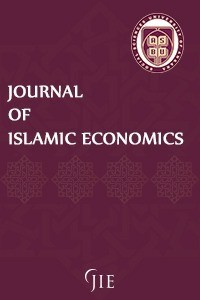The Impact of Covid-19 on Microfinance Institutions in Somalia
Anahtar Kelimeler:
Islamic Microfinance, Impact of Covid-19, Covid-19, Microfinance Institutions
The Impact of Covid-19 on Microfinance Institutions in Somalia
This study aims to investigate how Covid-19 has affected the microfinance institutions in Somalia. This study employed a qualitative descriptive approach by conducting a case study in Mogadishu and Hargeisa. The data of the study was collected through a questionnaire distributed to microfinance institutions in Somalia in 2021. The paper found that the number of MFIs that have been negatively affected by the epidemic was higher than the number affected positively or naturally. It also found that most MFIs witnessed high credit risks, and more than half of them have reduced lending to less than half due to Covid-19.
Keywords:
Islamic Microfinance, Covid-19, Microfinance Institutions, Somalia,
___
- Abdelkader, I. B., & Salem, A. B. (2013). Islamic vs Conventional Microfinance Institutions: Performance analysis in MENA countries. International Journal of Business and Social Research, 3(5), 219–233. https://doi.org/10.18533/ijbsr.v3i5.21
- Abdul Rahman, A. R. (2007). Islamic Microfinance: A Missing Component in Islamic Banking Kyoto Bulletin of Islamic Area Studies. Journal of Chemical Information and Modeling, 1(2), 38–53.
- Afrah, N.A. and Mohamed, A. . (2021). Economic Impacts of COVID-19 on Microfinance Institutions and Small Businesses: Empirical Survey from Somalia. European Journal of Business and Management, 13(6).
- Ahmad, S., Lensink, R., & Mueller, A. (2020). The double bottom line of microfinance: A global comparison between conventional and Islamic microfinance. World Development, 136, 105130. https://doi.org/10.1016/j.worlddev.2020.105130
- Ali, A. H., Abu-Hadi, A. O., & Ali, A. Y. S. (2013). The Accessibility of Microfinance for Small Businesses in Mogadishu, Somalia. International Journal of Humanities and Social Science, 3(11), 172–180.
- Bank, W. (2020). Poverty and Shared Prosperity.
- Bank, W. (2020). Somalia Economic Update. In World Bank (Issue 5). https://doi.org/10.1596/34239
- Bank, W. (2000). World development report. %0Aopenknowledge.worldbank.org/bitstream/handle/...
- Bank, W. (2019). Somalia Capacity Advancement, Livelihoods and Entrepreneurship, through Digital Uplift Project.
- Bellù, L. G., & Liberati, P. (2005). Impacts of policies on poverty: The definition of poverty. MPRA, 1–16.
- CGAP. (2020). Microfinance and COVID-19: Insights from CGAP’s Global Pulse Survey. https://www.cgap.org/blog/series/microfinance-and-covid-19-insights-cgaps-global-pulse-survey
- Dahir, A. M. (2015). The Challenges Facing Microfinance Institutions in Poverty Eradication : A Case Study in Mogadishu. International Journal of Humanities Social Sciences and Education (IJHSSE), 2(2), 56–62.
- Hagenaars, A. J. (1986). The perception of poverty. Elsevier. https://books.google.co.uk/books?hl=ar&lr=&id=wUCjBQAAQBAJ&oi=fnd&pg=PP1&dq=
- Jackson, R. L., Drummond, D. K., & Camara, S. (2007). What is qualitative research? Qualitative Research Reports in Communication, 8(1), 21–28. https://doi.org/10.1080/17459430701617879
- Khan, F. (2010). Waqf: An Islamic instrument of poverty alleviation-Bangladesh perspective. In S. Ismail, A.G. Hassan, M.E.M. Ismail, N. and Shaimi (Ed.), In International Conference-The Tawhidi Espitomology: Zakat and Waqf Economy. Institut Islam Hadhari Universiti Kebangsaan Malaysi.
- Khandelwal, A. K. (2007). Microfinance development strategy for India. Economic and Political Weekly, 42(13), 1127–1135.
- Koh E.T., O. W. L. (2000). Descriptive Research and Qualitative Research. In: Introduction to Nutrition and Health Research. Springer, Boston,. In Introduction to Nutrition and Health Research. https://doi.org/10.1007/978-1-4615-1401-5_12
- KPMG. (2004). Feasibility Study on Financial Services in Somalia: Updated Final Report.
- Lashley, J. G. (2004). Microfinance and Poverty Alleviateion in the Caribbean: A Strategic Overview. Journal of Microfinance/ESR Review, 6((1),6).
- Ledgerwood, J. (1999). Sustainable banking with the poor microfinance handbook.
- Mohamed, A. M. (2019). A Comparative Study of Islamic Microfinancing for SMES In Somlia and Nigeria : Experiences, Challenges and Opportunities”.(Doctoral dissertation, Hamad Bin Khalifa University (Qatar).
- Musse, A. M., Ab Rashid, R., & Zainol, Z. (2019). The Emergence of Islamic Banks in Somalia in the Post- Conflict Era : Prospects and Challenges. Indian-Pacific Journal of Accounting and Finance, 3(1), 41–49.
- Nimsith, S. I., Hilmy, H. M., & Safnas, I. F. (2019). The effect of Islamic micro finance on poverty alleviation: Study based on Eastern Province in Sri Lanka. http://192.248.66.13/handle/123456789/5183
- Otero, M. (1999). Bringing development back, into microfinance. Journal of Microfinance/ESR Review, 1((1),2).
- Rahman, R. A., & Dean, F. (2013). Challenges and solutions in Islamic microfinance. Humanomics, 29(4), 293–306. https://doi.org/10.1108/H-06-2012-0013
- Rokhman, W. (2013). The Effect of Islamic Microfinance on Poverty Alleviation: Study in Indonesia. Economic Review: Journal of Economics and Business, 11(2), 21–30.
- Somalia, C. B. (2021). Licensed Banks. Central Bank of Somalia. https://centralbank.gov.so/licensed-banks/
- Somalia, C. B. (2018). Central Bank of Somalia, Annual Report 2018. https://www.cbsl.gov.lk/en/publications/economic-and-financial-reports/annual-reports/annual-report-2018
- Wajdi Dusuki, A. (2008). Banking for the poor: The role of Islamic banking in microfinance initiatives. Humanomics, 24(1), 49–66. https://doi.org/10.1108/08288660810851469
- Xalane, M. A. E., & Salleh, M. C. M. (2019). The Role of Islamic Microfinance for Poverty Alleviation in Mogadishu, Somalia: An Exploratory Study. International Journal of Management and Applied Research, 6(4), 355–365. http://ijmar.org/v6n4/19-027.html
- Zeidy, I. A. (2020). Economic impact of covid-19 on micro, small and medium enterprises (msmes) in africa and policy options for mitigation. In Common market for Eastern and Southern Africa.
- Başlangıç: 2021
- Yayıncı: Ankara Sosyal Bilimler Üniversitesi
Sayıdaki Diğer Makaleler
The Islamic Financial Industry: What Is Its Role in the Moralization of Financial Markets?
Muzara’ah-Based Crowdfunding for Financing Small Farmers in Mali
Ghassan el-Şeyh, İslam Hukukunda Finansal Kiralama, Dimaşk: Daru’l-Kalem Yayınevi, 1.Baskı / 2010
The Islamic Economic System From a Normative Point of View Design Based on Questionnaire Tool
The Impact of Covid-19 on Microfinance Institutions in Somalia
